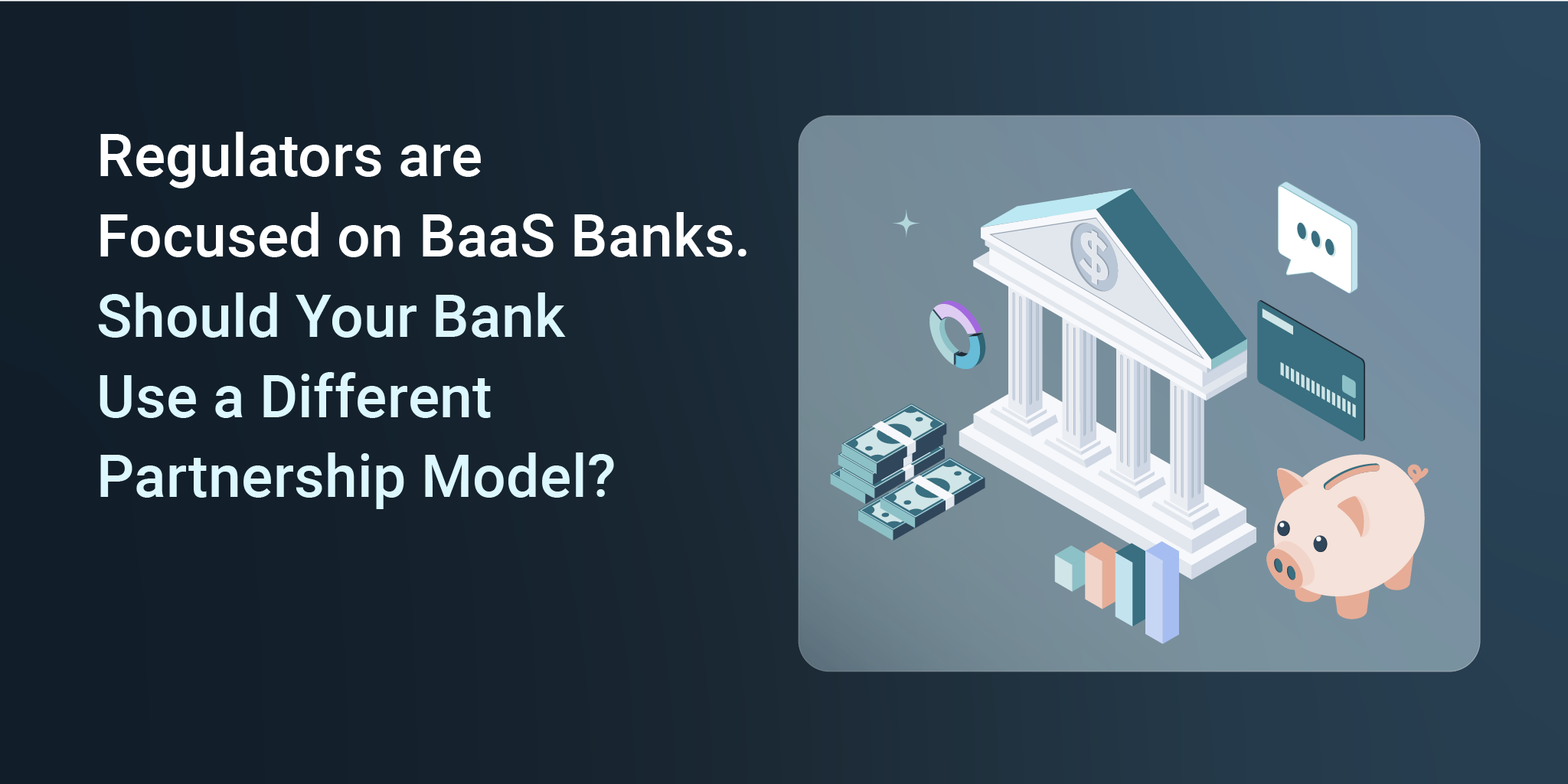Regulators are Focused on BaaS Banks. Should Your Bank Use a Different Partnership Model?
As a bank, one place you want to avoid ending up is in the crosshairs of regulators. Unfortunately for Banking-as-a-Service (BaaS) sponsor banks, that’s exactly what is happening to them. An S&P Global report published in January noted that 13.5% of severe enforcement actions (such as cease-and-desists and consent orders) issued by federal bank regulators were directed at BaaS banks. Given that the total number of BaaS banks sat at 136, which accounts for about 3% of the total number of banks in the US, this is a highly disproportionate level of regulatory activity.
But why are BaaS banks facing so much regulatory scrutiny? And should your bank consider using a different model for the fintech partnerships needed to drive digital transformation?
Lack of Regulatory Clarity Drives Scrutiny
In the BaaS model, banks serve as sponsors, allowing non-banking companies to offer banking services under their name. Though this type of partnership is not new (branded credit cards, for example, have existed for decades), the digitization of finance and the growth of the fintech space have led to a dramatic increase in the number and variety of BaaS-based products that are available to businesses and consumers.
While this expansion has created opportunities for banks to develop new revenue streams, it has also created compliance and risk management-related challenges that have brought about regulatory scrutiny. As the S&P Global report notes, part of the challenge is the lack of clear rules and guidelines for BaaS partnerships. As a result, even banks that are acting in good faith and are not attempting to circumvent regulatory issues could run into trouble as regulators work to improve their understanding of the risks involved in BaaS partnerships and establish standards for BaaS sponsor banks.
The lack of regulatory certainty and high potential for ending up in regulator crosshairs muddles the picture of the potential ROI of being a BaaS bank. Program revenue not only needs to cover any necessary increase in compliance and risk management costs but also be substantial enough to be worth the potential financial and reputational risk of facing a severe enforcement action.
While this has not stopped the BaaS space from growing and contributing to the rapid pace of change in the banking industry , it’s a good reason for banks that are exploring fintech partnerships to look at other partnership models – particularly those that are unable (or unwilling to) make the significant investments in upgrading their compliance and risk management operations that are needed to stay out of trouble.
The Advantage of the Platform Approach
An alternative partnership approach is the platform model. Effectively the inverse of BaaS, in the platform model, the bank retains full control over its banking services, how its customers can access them, and who can become a customer instead of letting a third party use its banking license and being partially at the mercy of the partner’s own compliance and risk management practices. The fintech partner, meanwhile, provides solutions that enable the bank to improve their product offerings instead of selling financial services directly under their own brand. These could include an improved mobile banking app, AI-powered underwriting, spend management tools, or a personalization engine. The partner’s teams can also provide support for your in-house teams instead of serving as another potential risk point.
Additionally, in the partnership model, the bank’s brand also remains the one that’s visible to customers in marketing materials. Any new product launched is seen as your bank’s product, further adding value to your brand and improving customer retention and acquisition – with the benefit of being much cheaper to launch than building it in-house. Revenue is also more predictable since it won’t depend on the effectiveness of your partner’s sales and marketing efforts.
Platform Partnerships for Credit Card Programs
One banking product that can benefit significantly from a strategic fintech partnership is your credit card program. Modern consumers expect high-value and feature-rich digital banking experiences, particularly business credit customers. However, these are expensive and time-consuming to build on your own, and your bank shouldn’t have to become a tech company to be more competitive.
Instead, you can modernize your credit card program quickly and easily by teaming up with a fintech platform partner like Torpago. Our PoweredBy solutions enable banks to enhance their business credit card programs by leveraging our white-label spend management platform and mobile app, which include features like expense management, spend controls, virtual card issuance, and easy accounting software integrations that customers are looking for. At the same time, we make it easy for you to manage your program through our Bank Admin Tool, which includes comprehensive reporting and dashboards, as well as complete access to your platform’s transaction data.
We also have expert teams that can provide you with the program support that you need. Whether it's risk, compliance, customer support, or marketing, we can help or do it for you. Request a demo today to learn more about Powered By and how we can help your bank build a business credit card program that drives growth and revenue.


